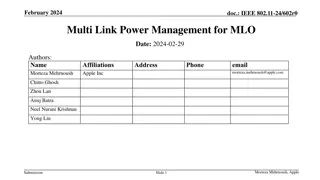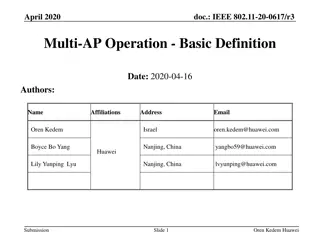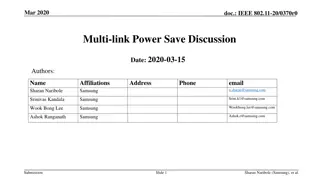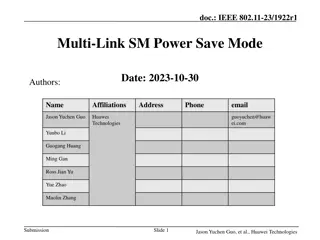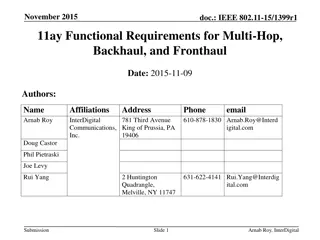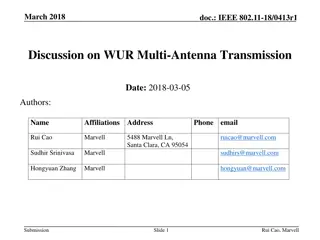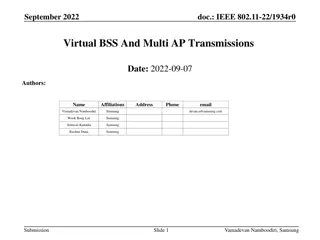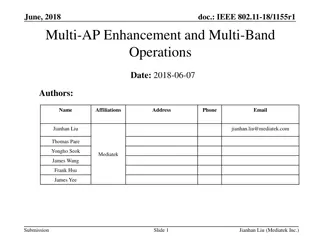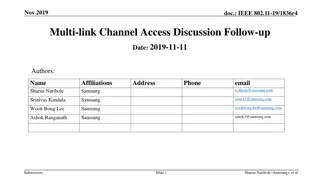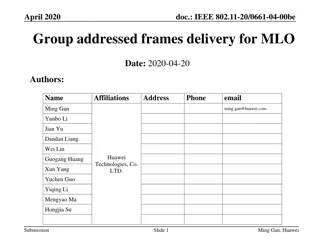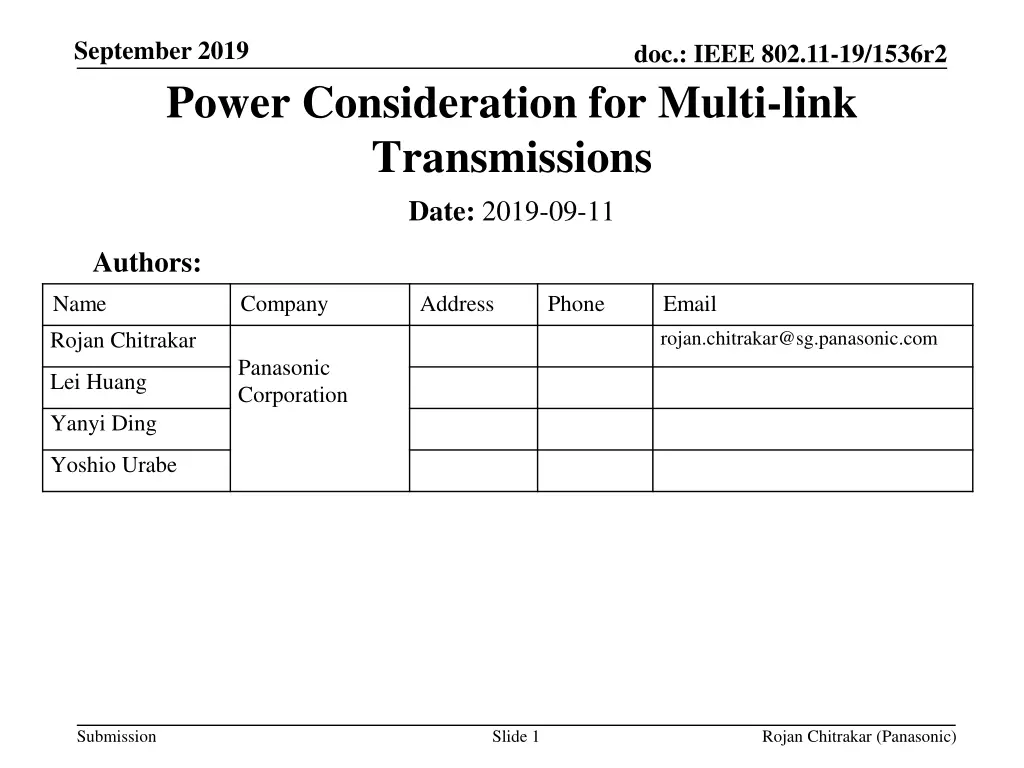
Power Consumption Considerations for Multi-link Transmissions in IEEE 802.11-19
Explore the impact of operating multiple radios on power consumption for multi-link capable devices in IEEE 802.11-19 standards. A potential solution is proposed to reduce power consumption by optimizing idle listening on primary and secondary links.
Download Presentation

Please find below an Image/Link to download the presentation.
The content on the website is provided AS IS for your information and personal use only. It may not be sold, licensed, or shared on other websites without obtaining consent from the author. If you encounter any issues during the download, it is possible that the publisher has removed the file from their server.
You are allowed to download the files provided on this website for personal or commercial use, subject to the condition that they are used lawfully. All files are the property of their respective owners.
The content on the website is provided AS IS for your information and personal use only. It may not be sold, licensed, or shared on other websites without obtaining consent from the author.
E N D
Presentation Transcript
September 2019 doc.: IEEE 802.11-19/1536r2 Power Consideration for Multi-link Transmissions Date: 2019-09-11 Authors: Name Rojan Chitrakar Company Address Phone Email rojan.chitrakar@sg.panasonic.com Panasonic Corporation Lei Huang Yanyi Ding Yoshio Urabe Submission Slide 1 Rojan Chitrakar (Panasonic)
September 2019 doc.: IEEE 802.11-19/1536r2 Overview Operating multiple radios to enable multi-link transmissions may substantially increase the power consumption of multi-link capable devices which may be a concern for battery powered non-AP Multi-link devices. We look into the issue of idle listening and suggest a possible solution to reduce power consumption. Submission Slide 2 Rojan Chitrakar (Panasonic)
September 2019 Power Consumption Assumptions doc.: IEEE 802.11-19/1536r2 The 802.11ax Simulation Scenarios [4] specifies the following power state parameters: Power State parameters Average Current Consumption [mA] Voltage = 1,1V, Band = { 2.4 GHz, 5 GHz }, NSS = { 1 }, Number of TX/RX antennas = { 1 }, TX power per antenna = { 15 dBm } Power State Bandwidth = { 20 MHz } Bandwidth = { 40 MHz } Bandwidth = { 80 MHz } Transmit 280 mA 280 mA 280 mA Active states Receive 100 mA 140 mA 200 mA Listen 50 mA 60 mA 75 mA Shallow Sleep 0.9 mA 0.9 mA 0.9 mA Deep Sleep 0.09mA 0.09mA 0.09mA Power consumption in all active states can be expected to increase multiple folds for Multi-link devices. Idle listening on multiple links may constitute significant ratio of a non-STA Multi-link device s power footprint. Submission Slide 3 Rojan Chitrakar (Panasonic)
September 2019 doc.: IEEE 802.11-19/1536r2 Discussions In light traffic load conditions, STAs affiliated with a non-AP Multi-link device (MLD) can be expected to be in the idle listen mode for most of the time. Even though a non-AP MLD is capable of multi-link transmissions/receptions, the actual duration of its multi-link communication may be low. Only listening on a single link when not engaged in multi-link communication may result in significant power savings for non-AP MLDs. Submission Slide 4 Rojan Chitrakar (Panasonic)
September 2019 A potential solution: Configuration For a non-AP Multi-link device (MLD), one supported link is assigned (by the AP MLD) as the primary link*. The primary link may be assigned during Association or post-association. The primary link is used as the default link for synchronization (e.g. to receive Beacon frames) as well as non-data frames TX/RX. The primary link may be re-assigned by the AP MLD at any time. The non-AP MLD only listens on the primary link during idle periods. doc.: IEEE 802.11-19/1536r2 The other links may be designated as secondary links*. The secondary links are used for high throughput TX/RX (e.g. by link aggregation or link transfer) . The secondary links are disabled or in PS doze state during idle periods. *Note1: An AP MLD may have multiple primary links as a deployment choice. Different non-AP MLDs may be assigned to different primary links for load-sharing etc. *Note2: Actual names may be changed. Submission Slide 5 Rojan Chitrakar (Panasonic)
September 2019 doc.: IEEE 802.11-19/1536r2 A potential solution: TX/RX 1. The AP MLD uses the primary link to indicate an upcoming multi-link transmission (DL/UL). AP MLD may also indicate the involved secondary links and the transmission time. The non-AP MLD activates the indicated secondary link/s. AP MLD schedules the multi-link transmission at the indicated time. The non-AP MLD de-activates the secondary link/s after completion of the multi-link transmission or after a certain timeout duration. 2. 3. 4. f Secondary Link - 2 6 GHz (160 MHz) Secondary Link - 1 5 GHz (80 MHz) Primary Link 2.4 GHz (40 MHz) t ON Multi-link Announcement frame UL Legend: DL Beacon frame ACK/BA frame OFF/Doze Submission Slide 6 Rojan Chitrakar (Panasonic)
September 2019 Simple Numerical Comparison Idle listening in three links vs single link: Assumptions: Each link operating on a 20 MHz channel 10% RX and 10% TX opportunity in one Beacon Interval (BI). Beacon TX in all 3 links. 1) Three links: doc.: IEEE 802.11-19/1536r2 Power State Bandwidth = 20 MHz Transmit (TX) 280 mA Receive (RX) 100 mA Listen (L) 50 mA Shallow Sleep (SS) 0.9 mA Deep Sleep (DS) 0.09mA TBTT Beacon Interval STA listens on all 3 links Multi-link RX Multi-link TX Beacon RX 2) Single link: TBTT Beacon Interval STA only listens on link-1. Other links in SS. 35.5% savings in this simple example. Submission Slide 7 Rojan Chitrakar (Panasonic)
September 2019 doc.: IEEE 802.11-19/1536r2 Conclusion In this contribution, we discussed the power consumption issue of non-AP Multi-link devices. We highlighted that idle listening may constitute significant ratio of a non-AP Multi-link device s power footprint. Only listening on a single link when not engaged in multi- link communication may result in significant power savings. We also shared a potential solution whereby a non-AP MLD is assigned a primary link. The non-AP MLD only listens on the primary link during idle periods. Submission Slide 8 Rojan Chitrakar (Panasonic)
September 2019 doc.: IEEE 802.11-19/1536r2 References 1) 2) 3) 4) IEEE 802.11-17/1184r1 Follow up discussions on Throughput Enhancement IEEE 802.11-19/823r0 Multi-link aggregation IEEE 802.11-19/0821r1 Multi-link Operation Discussion IEEE 802.11-14/980r16 TGax Simulation Scenarios Submission Slide 9 Rojan Chitrakar (Panasonic)
September 2019 doc.: IEEE 802.11-19/1536r2 Straw Poll 1 Do you support that a non-AP Multi-link device (MLD) that has more than one enabled links may only listen to a single link during idle periods? Y/N/A Submission Slide 10 Rojan Chitrakar (Panasonic)

